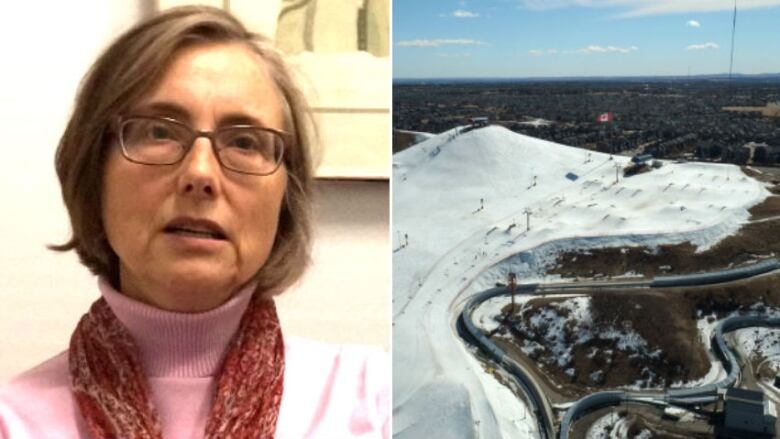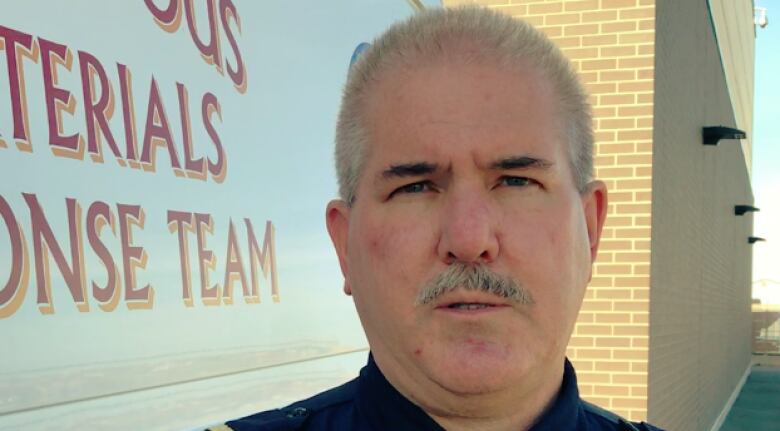Canada Olympic Park officials won't say how much ammonia it uses for sledding tracks and ice rinks
Woman who lives near COP wants to know how much of potentially deadly gas is being stored there

A Calgary woman is slamming what she calls the "huge risk" of an undisclosed amount of ammonia stored at Canada Olympic Park, demanding to know why the facility hasn't filed a hazardous materials risk assessment with the city.
A leak of the same toxic refrigerant killed three men in a leak at an arena in Fernie, B.C. on Oct. 17.Ammonia a colourless gas with a sharp, suffocating odour that can kill in seconds is commonly used in arenas and other recreation facilities across the city and the country.
Linda Nesset lives near Canada Olympic Park, which stores ammonia to keep the arenas and the luge and bobsled tracks ice-cold.
"It's a huge risk. It's flammable, it's explosive," said Nesset.
Nesset has been unsuccessful in her attempts to find out how much ammonia is stored at COP, in the city's northwest.
And she's not the only one who's unsure. Even the City of Calgary isn't sure exactly how much ammonia is stored onsite nor is the fire department, which would respond in case of a leak.
Nesset wants to know what the plan is in the event of a leak or release of the gas or a catastrophic accident. She wants to know why a hazardous materials risk assessment, which seems mandated by the city's own planning guidelines, hasn't been done for the site.
"With each land use application for these new developments around WinSport, there is a requirement in the area structure plan to have a risk analysis done, and it's not being done," said Nesset.
Policy not followed?
The city plan states:"In conjunction with a land use amendment application, a hazardous materials risk assessment for the ammonia storage facility on the CODA lands shall be submitted by CODA."
CODA stands for Calgary Olympic Development Association, the former name of WinSport.
The latest area structure plan was approved by council in July and states, "where 'shall' is used in a policy, the policy is considered mandatory."
The plan says the assessment should identify the hazardous materials and their quantities, estimate the expected frequency of occurrence of a hazardous event and assess the consequences of such an event.
It also states the assessment should demonstrate how the facility and operations would address risk reduction, emergency preparation, emergency response and risk communication.
Nesset says she filed a freedom of information request with the city to see if a risk assessment was done in 2015 as part of the proposed Trinity Hills development adjacent to COP.
She says she was told there was no such assessment.
"I think residents need to know that they're safe, that there's at least a well-thought-out evacuation plan in place," said Nesset.
Risk assessment not needed
A spokesperson for the city says an assessment isneeded only if the application involves hazardous materials.
"A hazardous materials risk assessment is required where the land use application proposes land uses that involve hazardous materials," said Madison Olyniuk in an email to CBCNews.
The city says COP submitted an assessment to the federal government, but it doesn't have a copy of the report, and it doesn't know how much is stored at the hill.
"That's not part of our jurisdictional purview, so no we don't have that information," said Mark Sasges, with the city's planning department.
He also points to a section in the plan that casts doubt as to whether a risk assessment is needed at all.
"The form and content of the studies may be re-addressed in any manner determined necessary for the review process," the plan states.
WinSport won't discuss ammonia
WinSport would not say how much ammonia is stored on site or what its plans are for the use of the refrigerant.
In May, WinSport received $10 million from the provincial government to cover half of the cost to upgrade the bobsled and luge track and the refrigeration unit. A government news release stated WinSport would be switching to an 'indirect' cooling system.
WinSport would not say what that means for the facility's dependence on ammonia.WinSport has refused requests for an interview.
It would also not confirm whether a risk assessment was filed with the federal government.
CBC News requested comment from Environment Canada but has not heard back.
"The modernization of the refrigeration system would result in increased energy efficiencies in the operation of the track and a reduction of the amount of ammonia used in the refrigeration system, with a greater reliance on glycol instead of ammonia," said Dale Oviatt in an email to CBCNews.
WinSport goes before council
Another land use amendment was set to go before city council on Monday, but the city confirmeda hazardous materials risk assessment would not be part of the application.
The proposed changes will allow commercial development along Canada Olympic Drive S.W. and Na'a Drive S.W.
The area structure plan for COP and the adjacent lands envisions "a world leading recreation, competition and tourism facility" along with room for entertainment, commercial and residential areas.
Fire department not responsible for regulation of ammonia
The Calgary Fire Department says it is not a regulatory body and does not maintain an active inventory of where ammonia is stored in the city.
Instead, it works with industries to help develop fire safety response plans.
"Our fire safety response plan has a component in there with hazardous materials that provides the first arriving crew about what might be in the facility and provides some assistance on how to mitigate the potential event," said Brian Ladds, the department's hazardous materials co-ordinator.

The fire department is responsible for enforcing the fire code, which covers a range of issues, from building maintenance to the number of fire extinguishers and emergency exits.
As for COP, a spokesperson for the fire department says the hazardous materials team has conducted training activities and tours of the site.
CBCNews reached out to provincial officials to comment on some of the regulations around ammonia storage but has not received a response.
Calgary doesn't plan to phase out ammonia at city facilities
The City of Calgary uses ammonia in all 12 of its arenas and two leisure centres to keep 19 sheets of ice chilled.
"No, we won't be phasing out ammonia," said Jarret Hoebers with Calgary Recreation.
"There's no concerns for us. Our facilities are operated as safely as we possibly can, but any time there's an opportunity to look at alternatives to operate in a more safe way, we will explore those," said Hoebers.

It's estimated 25 per cent of Canadian rinks have switched to Freon as the main cooling agent instead of ammonia.
From a public safety standpoint, Freon is a substantially safer compound, according to the Canadian Standards Association's mechanical refrigeration code, which ranks ammonia in the most toxic B2 category.
According to Health Canada, ammonia is a fire and explosion hazard, is "very toxic,"is corrosive to the respiratory tract, can cause severe skin burns and eye damage and can be fatal if inhaled.
Hoebers said there were four minor incidents in the past four years,and none required an evacuation.
20 ammonia leaks since 2012
The fire department says it responds, on average, to four ammonia leaks per year.Since 2012, there have been 20 calls two of them at indoor rinks.Six wereat cold storage and food processing plants.
While it could be months if not years before the cause of the Fernie deaths is uncovered, the MP for the area is demanding the use of ammonia be phased out in Canada.
Wayne Stetski called on the federal government to work with the provinces and municipalities to phase out ammonia in all of the country's ice rinks and curling arenas.
The New Democrat, who represents the Kootenay-Columbia riding, told the House of Commons that since 2007there have been 50 ammonia leaks in Canada, with many of them "resulting in injuries and deaths."
Linda Nesset acknowledges that there havebeen no major ammonia leaks or incidents at COP but she says the same could be said in Fernie before the three fatalities.
"We can't stop, heaven forbid, some kind of catastrophic accident or fire that could happen there. We can't stop these things. We just have to be the best prepared we can," said Nesset.












_(720p).jpg)


 OFFICIAL HD MUSIC VIDEO.jpg)
.jpg)



























































































